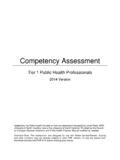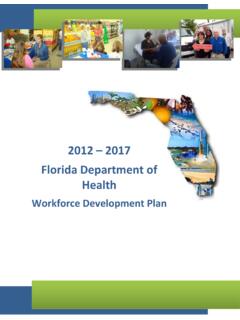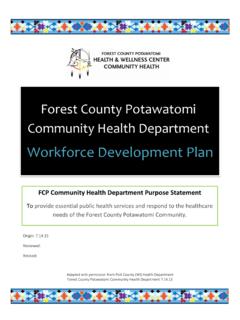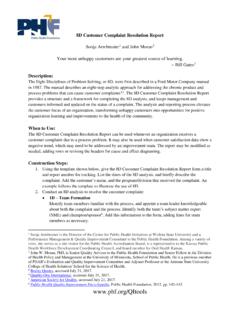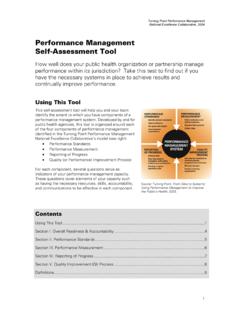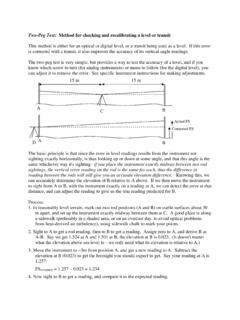Transcription of Guidebook for Performance Measurement (public health)
1 First in a series of Turning Pointresources on Performance Management1 Patricia LichielloBernard J. Turnock, ConsultantGuidebook for PerformanceMeasurementTurningPoint Collaborating for a New Century in Public HealthAcknowledgements 1 This Guidebook benefited from the thoughtful and good-natured input of twokey people:Bernard J. Turnock, , ConsultantClinical Professor of Community Health SciencesUniversity of Illinois at Chicago School of Public HealthJohn T. (Jack) Thompson, ReviewerSenior LecturerUniversity of Washington, School of Public HealthSenior ConsultantUniversity of Washington Turning Point National Program OfficeInfrastructure support, including computer and communications technology,was provided by:University of Washington Health Policy Analysis ProgramSchool of Public Health and Community of us affiliated with the technical assistance program of the University ofWashington Turning Point National Program Office would like to express ourgratitude to the many Turning Point state and local partners that participated intechnical assistance workshops to help determine the contents of thisguidebook.
2 Their input and good humor were invaluable. The author, inparticular, hopes that the Guidebook does justice to their candor,thoughtfulness, and willingness to be she hopes they find it Turning Point Guidebook for Performance Measurementwas researched and written by Patricia Lichiello, , AICP, Senior Policy Analyst with the University of Washington Health Policy Analysis Program, undercontract to the Robert Wood Johnson Foundation/University of Washington Turning Point National Program : 1 What Do We Mean By Performance Measurement ? 9 What is a Performance measure, exactly?11 Then what is a Performance standard?12 How do other Performance assessment activities relate to Performance Measurement ?
3 13 Performance Measurement is an aspect of Performance managementPerformance Measurement is an aspect of program evaluationPerformance Measurement might be referred to as Performance monitoring or Performance auditingPerformance Measurement is 15 Chapter 2 Performance Measurement In Public Health17 Are we unique?17 Diverse services provided directly to diverse constituents with diverse health concerns17 Core functions and essential public health services19 Healthy people 2000and 201021 Chapter 3 Why Do Performance Measurement ?25 Seven good reasons to conduct Performance measurement25Is Performance budgeting an eighth good reason?34 Reasons to hesitate before taking on Performance measurement362 Guidebook for Performance MeasurementTable of ContentsTable of Contents 3 Chapter 4 Key Components In Developing An Effective PerformanceMeasurement Process41 Incorporate stakeholder input41 Promote top leadership support47 Create a mission, long-term goals, and objectives50 Formulate short-term goals57 Devise a simple, manageable approach57 Provide technical assistance67 Chapter 5A Few Words About Reporting Results71 Provide context73 Create clear, easy-to-read, understandable report designs74 Determine reporting frequency77 Offer staff training77 Glossary81 Introduction 5"Accountability for Results!
4 " ..a rallying cry that has taken our country by storm. And it seems that those mosteager to be swept into the tempest are our government programs. Publicprograms of every stripe and size across the nation are shifting from seeingthemselves as accountable for creating and carrying out activities to beingaccountable for achieving results meeting goals, effecting change, and improvingthe quality of their transformation can be exciting: changing the way you work, the way youassess your work, and the way you inform others of your progress. And it can bedifficult: redefining roles and responsibilities, creating new collaborations,overcoming resistance to in public health, such struggling to understand a program's role and striving tofairly evaluate how well it's carrying out that role really isn't 've been at this for decades!
5 Public health has been measuring itself in one way or another for over 80 years [1].We've been surveying and assessing and comparing the work of state and localpublic health organizations across this country since about 1914, always with theintent of gathering information to improve public health help us in these assessments, we've developed many ways of looking at thefundamental activities of public health: the basic six local public health services (1945) optimal responsibilities of local health departments (1950) the eight basic services of local public health (1963) model standards (1985) the three core functions (1988) 332 national health objectives for the year 2000 (1990) ten organizational practices (1990) and now, the essential public health services (1994) [1]And this is just a few of these efforts there are many others you might bethinking of right now (yes, likeAPEXPH)!
6 Along the way, the emphasis of all these evaluations and assessment tools hasshifted back and forth between examining whether public health was doing thingsIntroductionright, and examining whether the right things were being done. We havecounted visits and inspections and immunizations(Are we doing things right?)and we have conducted community health assessments (Are the right thingsbeing done?)Yet as time has marched on, we've been inching ever closeralong the "doing things right doing theright things" continuum to the "rightthings" end: toward measuring resultsrather than only measuring resources andactivities, toward measuring outcomesrather than just counting inputs as government programs across thecountry jump into the stormy sea of"Accountability for Results!
7 ", we in publichealth should take pause and a deepbreath. Those big waves of performancemeasurement zeal we see sweeping thenation don't have to crash on top of us. We can use our history andexperience to ride them! Public health is on strong footing when itcomes to Performance Measurement we have a history of trial anderror in assessing our work and assessing the needs of those weserve. When it comes to this most recent version of organizationalself assessment, we can take what we've learned and build on for what we don't know, a little common sense and some goodinformation will help keep us upright in the we do need to watch out for the is one of the most perplexing things aboutperformance Measurement , and can waters.
8 Asthe rest of this Guidebook and any person involved in performancemeasurement will attest, this enterprise is not for the lexical faint of heart!About this guidebookThe Turning Point Guidebook for Performance Measurementoffers thefundamentals of Performance Measurement in public health. It covers basicinformation about what we mean by Performance Measurement in general, andbackground information on Performance Measurement in public health, inparticular. It offers reasons for developing a Performance measurementprocess and a description of the key components in developing such a offers Performance Measurement strategies tried by public healthpractitioners across the country and by other public and private for Performance MeasurementAssessment of service delivery at thelocal level of government is not new,but linking the measures, orindicators, to program mission;setting Performance targets; andregularly reporting on theachievement of target levels ofperformance are new features in theperformance Measurement movementsweeping across the public andnonprofit sectors in the United States.
9 Kathryn E. Newcomer [2]Jargon Alert!The Guidebook provides an overview of thefundamental steps the keycomponents in developing a Performance Measurement process. Thesefundamentals are critical to developing a process that is accepted, successful,and respected. The Guidebook does not offer a set of step-by-step literature, the World Wide Web, and several public and private performancemeasurement consultants offer many such guidelines that walk you througheach step of the Performance Measurement process. Although no two ofthese step-by-step guidelines are completely alike, there is one thing aboutalmost all of them that is key: they have several particular, and clearlyfundamental, steps in common.
10 It is these fundamental steps, or keycomponents, that are described in this 1 of the Guidebook offers an answer to the question, What do wemean by Performance Measurement ? It then provides definitions for somekey terms, including Performance measure, Performance standard, andperformance management, and offers some insight into how the termsprogram evaluation and Performance monitoring and auditing are 2 describes some of the unique attributes of public health thatinfluence the design and implementation of a Performance measurementprocess in this field of work. Chapter 3 offers seven good reasons forconducting Performance Measurement , no matter what field you're in.



